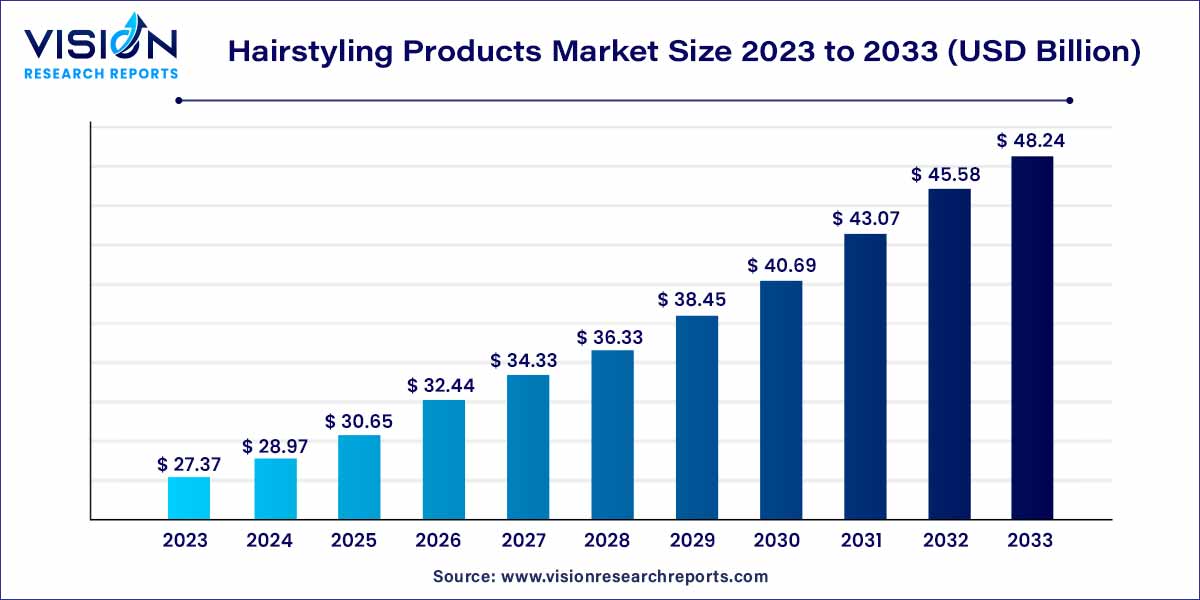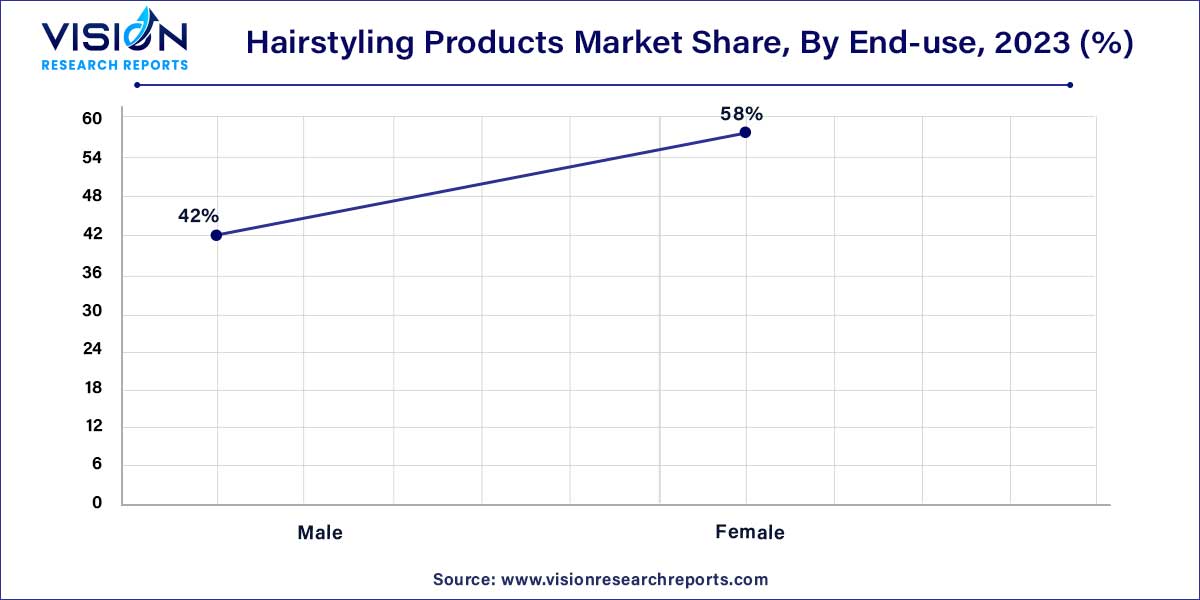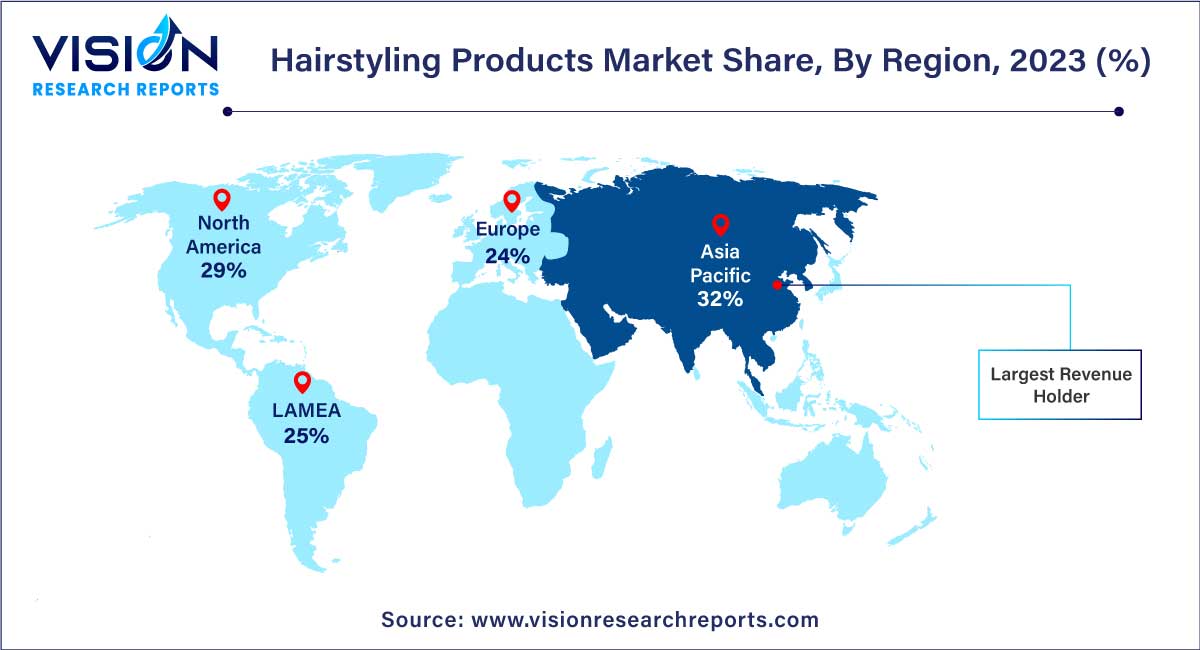The global hairstyling products market size was estimated at around USD 27.37 billion in 2023 and it is projected to hit around USD 48.24 billion by 2033, growing at a CAGR of 5.83% from 2024 to 2033.

The hairstyling products market is a dynamic and rapidly expanding sector within the broader beauty and personal care industry. Characterized by a diverse range of products designed to enhance, shape, and beautify hair, this market has experienced consistent growth driven by changing consumer preferences, advancements in technology, and a heightened focus on personal grooming.
The growth of the hairstyling products market can be attributed to several key factors driving consumer demand and industry expansion. One primary factor is the evolving beauty and grooming trends, with consumers increasingly seeking innovative and versatile hairstyling solutions to express their individuality. The continual advancements in hairstyling technology and formulations contribute significantly, as manufacturers invest in research and development to introduce cutting-edge products. Moreover, the heightened awareness of environmental sustainability has led to a surge in demand for eco-friendly hairstyling options, aligning with the growing emphasis on ethical and environmentally responsible consumer choices. The prevalence of e-commerce platforms has transformed the market landscape, providing consumers with convenient access to a diverse range of products and influencing purchasing behavior. Globalization and cultural influences have also played a pivotal role, fostering the exchange of beauty practices and shaping consumer preferences. The influence of professional salons, regulatory standards ensuring product safety, and the ever-growing impact of digital marketing further contribute to the overall expansion of the hairstyling products market. As these growth factors continue to intersect, the market is poised for sustained development and adaptation to changing consumer needs.
| Report Coverage | Details |
| Market Revenue by 2033 | USD 48.24 billion |
| Growth Rate from 2024 to 2033 | CAGR of 5.83% |
| Revenue Share of Asia Pacific in 2023 | 32% |
| CAGR of Middle East and Africa from 2023 to 2032 | 6.25% |
| Base Year | 2023 |
| Forecast Period | 2024 to 2033 |
| Market Analysis (Terms Used) | Value (US$ Million/Billion) or (Volume/Units) |
Hair sprays accounted for a maximum share of 32% in 2023. Robust product innovation, by new entrants, related to hair styling range is providing the necessary boost for such products. In September 2021, actress Jennifer Aniston launched her hair care brand LolaVie. The brand debuted with a multitasking, lightweight hair spray that is designed to detangle and smoothen hair. It is formulated with lemon extract, vegetable ceramides, and chia seeds that protect from damage.
Pomade is anticipated to register a CAGR of 7.35% during forecast period. Hair pomades are preferred by many because they provide a stronghold and a shiny finish, allowing for versatile and long-lasting hairstyling, making them especially popular for classic and slicked-back hairstyles. Zenn Hair Care, a Philadelphia, Pennsylvania-based company that saw a fourfold increase in revenue in 2023, provides a line of organic products designed specifically for Black people with naturally occurring hair. In 2020, the firm debuted its first product, a hair growth pomade composed of only natural and pure components.
Female consumers dominated the market with a share of 58% in 2023. As more women enter the workforce and face longer hours and imbalanced work-life demands, the use of hairstyling products becomes a convenient way to maintain a polished and professional appearance amidst their busy schedules. Unilever collaborates with Black Women through its Polycultural Center of Excellence salon to comprehend their hair care and styling preferences and develop products tailored to textured hair, targeting a share of the USD 1.8 billion Black hair care market, where women often use twice as many products for their hair needs.

Demand of hairstyling products for men is set to expand at a CAGR of about 6.36%. The growing awareness of personal well-being and beauty among male consumers is the main driver of the market. The most notable growth areas in men's grooming sector, according to Dr. Caroline Brooks, creator of The Glass House, an inclusive salon and spa located in Dubai, are hairstyling, customized grooming sets, and beard care. Furthermore, men's interest in personal care goods, such as hairstyling, has significantly expanded due to social media's growing prevalence.
Hypermarkets and supermarkets dominated the industry with a share of 42% in 2023. This is due to their wide product variety, accessibility, and ability to cater to diverse consumer preferences in one convenient location. In January 2023, customizable products brand Function of Beauty launched its new hair styling products exclusively at Target. The line includes a texturizing spray, mousse, curl cream, and styling gel. These channels will continue to dominate due to their established brand relationships and the trust consumers have in finding reputable hairstyling products, further solidifying their market presence.
The online/e-commerce channel is expected to witness a strong CAGR of 6.48% during the forecast period. Online platforms have enabled manufacturers to gain potential customers, improve their communication, track finances, and boost brand awareness in a cost-effective manner. According to a report conducted by German performance marketing solutions provider Admitad, the amount of beauty product sales made online worldwide increased by 11% in 2022 and has already surpassed 15% in the first half of 2023. Online sales of hairstyling products are set to grow as consumers seek convenience, a wide selection, and the ability to compare prices and reviews from the comfort of their homes.
Asia Pacific dominated the industry with a share of 32% in 2023 due to its large and diverse consumer base, rapid urbanization, and increasing disposable income. In order to increase their market share and maintain their competitiveness, companies have been increasing their presence in this region. German Henkel Consumer Brands stated in June 2023 that it planned to introduce its international hairstyling brand Taft in India in order to increase the size of its hairstyling product line in that nation. The business announced the release of eighteen products in four different formats-wax, gel, mousse, and hairspray-as part of a unisex line emphasizing male customers.

Middle East and Africa is set to grow at a CAGR of about 6.25% during forecast period. The demand is poised to grow due to a rising trend in personal grooming and beauty consciousness, coupled with a growing population and an expanding middle-class demographic. Retailer of omnichannel beauty and lifestyle products Nykaa stated that it has inked a deal with the Middle East's Apparel Group to establish an omnichannel beauty retail platform in nations including Bahrain, Oman, Kuwait, Qatar, and others, in an effort to increase its footprint in the GCC (Gulf Cooperation Council).
L'Oréal Canada's Professional Products Division launched a free online Diversity and Inclusion training program for hairdressers nationwide in September 2022. The goal of this program, "Power of the Collective," is to educate hairstylists about the variety of hair types while fostering a welcoming and reliable salon atmosphere for both clients and stylists. Six courses focused on haircutting are part of the first-year curriculum, and they are taught by foreign experts who are specialists in particular hair types. The focus in the following years will be on hair coloring in the third year and styling in the second.
As part of its strategic entrance into the burgeoning luxury haircare sector within the beauty industry, Procter & Gamble entered into an acquisition deal in December 2021 for the haircare and style brand Ouai, owned by celebrity hairstylist Jen Atkin. Notably, Ouai intends to continue operating independently and stay apart from P&G's larger operations.
By Product
By End-use
By Distribution Channel
By Region
Chapter 1. Introduction
1.1. Research Objective
1.2. Scope of the Study
1.3. Definition
Chapter 2. Research Methodology
2.1. Research Approach
2.2. Data Sources
2.3. Assumptions & Limitations
Chapter 3. Executive Summary
3.1. Market Snapshot
Chapter 4. Market Variables and Scope
4.1. Introduction
4.2. Market Classification and Scope
4.3. Industry Value Chain Analysis
4.3.1. Raw Material Procurement Analysis
4.3.2. Sales and Distribution Product Analysis
4.3.3. Downstream Buyer Analysis
Chapter 5. COVID 19 Impact on Hairstyling Products Market
5.1. COVID-19 Landscape: Hairstyling Products Industry Impact
5.2. COVID 19 - Impact Assessment for the Industry
5.3. COVID 19 Impact: Global Major Government Policy
5.4. Market Trends and Opportunities in the COVID-19 Landscape
Chapter 6. Market Dynamics Analysis and Trends
6.1. Market Dynamics
6.1.1. Market Drivers
6.1.2. Market Restraints
6.1.3. Market Opportunities
6.2. Porter’s Five Forces Analysis
6.2.1. Bargaining power of suppliers
6.2.2. Bargaining power of buyers
6.2.3. Threat of substitute
6.2.4. Threat of new entrants
6.2.5. Degree of competition
Chapter 7. Competitive Landscape
7.1.1. Company Market Share/Positioning Analysis
7.1.2. Key Strategies Adopted by Players
7.1.3. Vendor Landscape
7.1.3.1. List of Suppliers
7.1.3.2. List of Buyers
Chapter 8. Global Hairstyling Products Market, By Product
8.1. Hairstyling Products Market, by Product, 2024-2033
8.1.1 Hair Gel
8.1.1.1. Market Revenue and Forecast (2021-2033)
8.1.2. Hair Wax
8.1.2.1. Market Revenue and Forecast (2021-2033)
8.1.3. Hair Mousse
8.1.3.1. Market Revenue and Forecast (2021-2033)
8.1.4. Hair Spray
8.1.4.1. Market Revenue and Forecast (2021-2033)
8.1.5. Pomade
8.1.5.1. Market Revenue and Forecast (2021-2033)
8.1.6. Others
8.1.6.1. Market Revenue and Forecast (2021-2033)
Chapter 9. Global Hairstyling Products Market, By End-use
9.1. Hairstyling Products Market, by End-use, 2024-2033
9.1.1. Male
9.1.1.1. Market Revenue and Forecast (2021-2033)
9.1.2. Female
9.1.2.1. Market Revenue and Forecast (2021-2033)
Chapter 10. Global Hairstyling Products Market, By Distribution Channel
10.1. Hairstyling Products Market, by Distribution Channel, 2024-2033
10.1.1. Hypermarkets and Supermarkets
10.1.1.1. Market Revenue and Forecast (2021-2033)
10.1.2. Convenience Stores
10.1.2.1. Market Revenue and Forecast (2021-2033)
10.1.3. Specialty Stores
10.1.3.1. Market Revenue and Forecast (2021-2033)
10.1.4. Online
10.1.4.1. Market Revenue and Forecast (2021-2033)
10.1.5. Others
10.1.5.1. Market Revenue and Forecast (2021-2033)
Chapter 11. Global Hairstyling Products Market, Regional Estimates and Trend Forecast
11.1. North America
11.1.1. Market Revenue and Forecast, by Product (2021-2033)
11.1.2. Market Revenue and Forecast, by End-use (2021-2033)
11.1.3. Market Revenue and Forecast, by Distribution Channel (2021-2033)
11.1.4. U.S.
11.1.4.1. Market Revenue and Forecast, by Product (2021-2033)
11.1.4.2. Market Revenue and Forecast, by End-use (2021-2033)
11.1.4.3. Market Revenue and Forecast, by Distribution Channel (2021-2033)
11.1.5. Rest of North America
11.1.5.1. Market Revenue and Forecast, by Product (2021-2033)
11.1.5.2. Market Revenue and Forecast, by End-use (2021-2033)
11.1.5.3. Market Revenue and Forecast, by Distribution Channel (2021-2033)
11.2. Europe
11.2.1. Market Revenue and Forecast, by Product (2021-2033)
11.2.2. Market Revenue and Forecast, by End-use (2021-2033)
11.2.3. Market Revenue and Forecast, by Distribution Channel (2021-2033)
11.2.4. UK
11.2.4.1. Market Revenue and Forecast, by Product (2021-2033)
11.2.4.2. Market Revenue and Forecast, by End-use (2021-2033)
11.2.4.3. Market Revenue and Forecast, by Distribution Channel (2021-2033)
11.2.5. Germany
11.2.5.1. Market Revenue and Forecast, by Product (2021-2033)
11.2.5.2. Market Revenue and Forecast, by End-use (2021-2033)
11.2.5.3. Market Revenue and Forecast, by Distribution Channel (2021-2033)
11.2.6. France
11.2.6.1. Market Revenue and Forecast, by Product (2021-2033)
11.2.6.2. Market Revenue and Forecast, by End-use (2021-2033)
11.2.6.3. Market Revenue and Forecast, by Distribution Channel (2021-2033)
11.2.7. Rest of Europe
11.2.7.1. Market Revenue and Forecast, by Product (2021-2033)
11.2.7.2. Market Revenue and Forecast, by End-use (2021-2033)
11.2.7.3. Market Revenue and Forecast, by Distribution Channel (2021-2033)
11.3. APAC
11.3.1. Market Revenue and Forecast, by Product (2021-2033)
11.3.2. Market Revenue and Forecast, by End-use (2021-2033)
11.3.3. Market Revenue and Forecast, by Distribution Channel (2021-2033)
11.3.4. India
11.3.4.1. Market Revenue and Forecast, by Product (2021-2033)
11.3.4.2. Market Revenue and Forecast, by End-use (2021-2033)
11.3.4.3. Market Revenue and Forecast, by Distribution Channel (2021-2033)
11.3.5. China
11.3.5.1. Market Revenue and Forecast, by Product (2021-2033)
11.3.5.2. Market Revenue and Forecast, by End-use (2021-2033)
11.3.5.3. Market Revenue and Forecast, by Distribution Channel (2021-2033)
11.3.6. Japan
11.3.6.1. Market Revenue and Forecast, by Product (2021-2033)
11.3.6.2. Market Revenue and Forecast, by End-use (2021-2033)
11.3.6.3. Market Revenue and Forecast, by Distribution Channel (2021-2033)
11.3.7. Rest of APAC
11.3.7.1. Market Revenue and Forecast, by Product (2021-2033)
11.3.7.2. Market Revenue and Forecast, by End-use (2021-2033)
11.3.7.3. Market Revenue and Forecast, by Distribution Channel (2021-2033)
11.4. MEA
11.4.1. Market Revenue and Forecast, by Product (2021-2033)
11.4.2. Market Revenue and Forecast, by End-use (2021-2033)
11.4.3. Market Revenue and Forecast, by Distribution Channel (2021-2033)
11.4.4. GCC
11.4.4.1. Market Revenue and Forecast, by Product (2021-2033)
11.4.4.2. Market Revenue and Forecast, by End-use (2021-2033)
11.4.4.3. Market Revenue and Forecast, by Distribution Channel (2021-2033)
11.4.5. North Africa
11.4.5.1. Market Revenue and Forecast, by Product (2021-2033)
11.4.5.2. Market Revenue and Forecast, by End-use (2021-2033)
11.4.5.3. Market Revenue and Forecast, by Distribution Channel (2021-2033)
11.4.6. South Africa
11.4.6.1. Market Revenue and Forecast, by Product (2021-2033)
11.4.6.2. Market Revenue and Forecast, by End-use (2021-2033)
11.4.6.3. Market Revenue and Forecast, by Distribution Channel (2021-2033)
11.4.7. Rest of MEA
11.4.7.1. Market Revenue and Forecast, by Product (2021-2033)
11.4.7.2. Market Revenue and Forecast, by End-use (2021-2033)
11.4.7.3. Market Revenue and Forecast, by Distribution Channel (2021-2033)
11.5. Latin America
11.5.1. Market Revenue and Forecast, by Product (2021-2033)
11.5.2. Market Revenue and Forecast, by End-use (2021-2033)
11.5.3. Market Revenue and Forecast, by Distribution Channel (2021-2033)
11.5.4. Brazil
11.5.4.1. Market Revenue and Forecast, by Product (2021-2033)
11.5.4.2. Market Revenue and Forecast, by End-use (2021-2033)
11.5.4.3. Market Revenue and Forecast, by Distribution Channel (2021-2033)
11.5.5. Rest of LATAM
11.5.5.1. Market Revenue and Forecast, by Product (2021-2033)
11.5.5.2. Market Revenue and Forecast, by End-use (2021-2033)
11.5.5.3. Market Revenue and Forecast, by Distribution Channel (2021-2033)
Chapter 12. Company Profiles
12.1. Procter & Gamble.
12.1.1. Company Overview
12.1.2. Product Offerings
12.1.3. Financial Performance
12.1.4. Recent Initiatives
12.2. L'Oréal Groupe.
12.2.1. Company Overview
12.2.2. Product Offerings
12.2.3. Financial Performance
12.2.4. Recent Initiatives
12.3. Revlon, Inc.
12.3.1. Company Overview
12.3.2. Product Offerings
12.3.3. Financial Performance
12.3.4. Recent Initiatives
12.4. Kao Corporation.
12.4.1. Company Overview
12.4.2. Product Offerings
12.4.3. Financial Performance
12.4.4. Recent Initiatives
12.5. Unilever.
12.5.1. Company Overview
12.5.2. Product Offerings
12.5.3. Financial Performance
12.5.4. Recent Initiatives
12.6. Shiseido Company, Limited
12.6.1. Company Overview
12.6.2. Product Offerings
12.6.3. Financial Performance
12.6.4. Recent Initiatives
12.7. Henkel AG & Co. KGaA.
12.7.1. Company Overview
12.7.2. Product Offerings
12.7.3. Financial Performance
12.7.4. Recent Initiatives
12.8. Mandom Corporation
12.8.1. Company Overview
12.8.2. Product Offerings
12.8.3. Financial Performance
12.8.4. Recent Initiatives
12.9. Amorepacific.
12.9.1. Company Overview
12.9.2. Product Offerings
12.9.3. Financial Performance
12.9.4. Recent Initiatives
12.10. Flora and Curl
12.10.1. Company Overview
12.10.2. Product Offerings
12.10.3. Financial Performance
12.10.4. Recent Initiatives
Chapter 13. Research Methodology
13.1. Primary Research
13.2. Secondary Research
13.3. Assumptions
Chapter 14. Appendix
14.1. About Us
14.2. Glossary of Terms
 Cross-segment Market Size and Analysis for
Mentioned Segments
Cross-segment Market Size and Analysis for
Mentioned Segments
 Additional Company Profiles (Upto 5 With No Cost)
Additional Company Profiles (Upto 5 With No Cost)
 Additional Countries (Apart From Mentioned Countries)
Additional Countries (Apart From Mentioned Countries)
 Country/Region-specific Report
Country/Region-specific Report
 Go To Market Strategy
Go To Market Strategy
 Region Specific Market Dynamics
Region Specific Market Dynamics Region Level Market Share
Region Level Market Share Import Export Analysis
Import Export Analysis Production Analysis
Production Analysis Others
Others